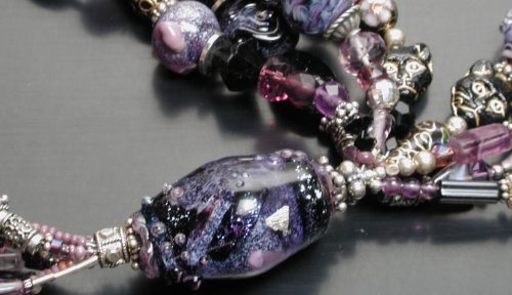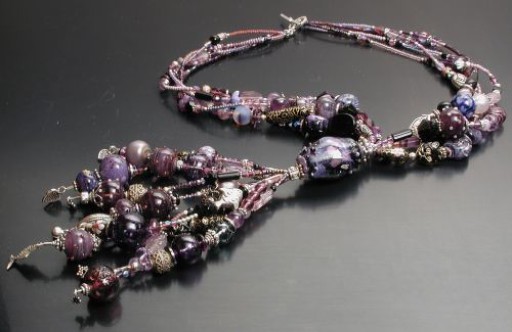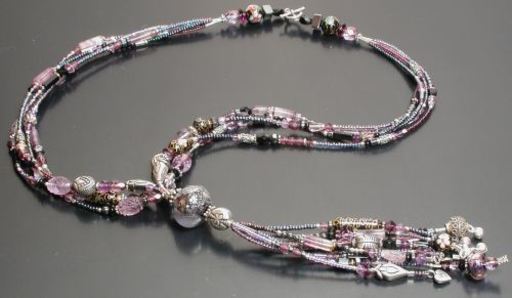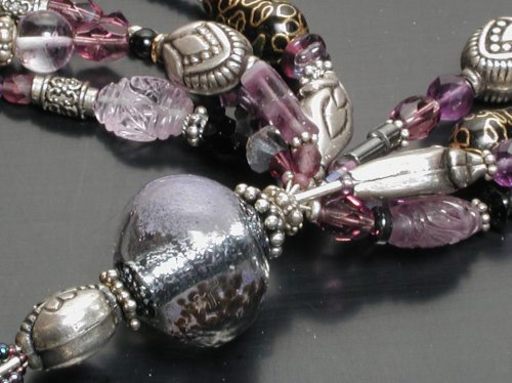On the lumpen bracelet page I note that the large purple necklace, though designed before the bracelets, was strung afterwards, because I had to make the focal bead first. Like all lumpens, this bead started out as a hollow bicone, but took a couple of detours to pick up some thompson enamels and frit which I cased before adding the dichro. Then I put on some silver foil triangles and trailed some dots; thus the focal point is a more elaborate bead than the ones I've used in the past.

closeup of purple barrel bead: dichroic glass, thompson enamel, punched heavy silver foil triangles on a hollow base bead.
The Buddha necklace has some accent beads through which the multiple strands of tumble faceted garnets all go through as a transition point before separating again into the mixed bead portion of the necklace. When we were making the rear part of the lumpen necklaces all seed beads (or perhaps seed beads accented with a few 3 and 4mm beads) this transition made a lot of sense; however, as I've made more, I've tended graduate the accent beads from 3mm all the way to 10mm or more, so that transition not only was no longer needed, but broke up the flow of the design. So for this piece I took those two larger side accents out. Though this piece does have three catheads and a couple of fish for them to fight over, it isn't officially the go to town use every cat and fish bead I can lay my hands on.

Glass, (stained, effetre, satake, possibly some bullseye lampworked; austrian and czech pressed; seed beads), sterling, cloisonne, mixed metals, fluorite, black onyx and amethyst on .018 49 strand beadalon. October, 2002. Photograph, 19dec2002
Of course, having got out all those beads, I didn't want to make just one; so when I made the large focal above, I was already thinking about a somewhat smaller necklace, of greater delicacy. For this piece I made a dichro core, over which I put thompson enamels and reduction frits, the latter to provide a pickup for silver and possibly hematite accents.

lampworked glass beads, including dichro core focal with reduction frit, Austrian and Czech crystal, Japanese, French?, and Czech seed beads, cloisonne, mixed metals (primarily silver), fluorite, hematite, black onyx and amethyst. .018 49 strand beadalon. October, 2002. Private collection.
This time I wanted to use the elegant single strand finish near the clasp Page had incorporated in her lumpens. The biggest problem with this approach is that beads small enough to go near the clasp also tend to have small holes, so fitting two doubled (total 4) strands of .018 beadalon is a bit tricky. I just hate it when the loops of stringing material crosses over itself, which it inevitably seems to do when the holes are so small it doesn't have room to shift. The solution, though tiresome, is simply to string two strands; then string strand 3 and 4 one at a time, carefully placing them so they lay neatly, instead of jamming the bead on all 4 at once.

This bead is starts out as a solid dichro cylinder, around which the (hollow) outer jacket is partially covered with thompson enamels and reduction frit.
I used the ultra small liquid silver beads called ‘dynamites’ to provide smooth transition so that the multiple strands beadalon would come out of and feed into transition beads, which were carefully selected for hole size to pull the strands in tightly but not kink them. With a great deal of discipline I kept from using any beads more than 8mm thick...perhaps some day I'll manage to keep it down to 6mm. The challange would be good for me, no doubt. The other major difference is that this necklace has only two lampworked beads, instead of 20plus.
Unless otherwise noted, text, image and objects depicted therein copyright 1996--present sylvus tarn.
Sylvus Tarn